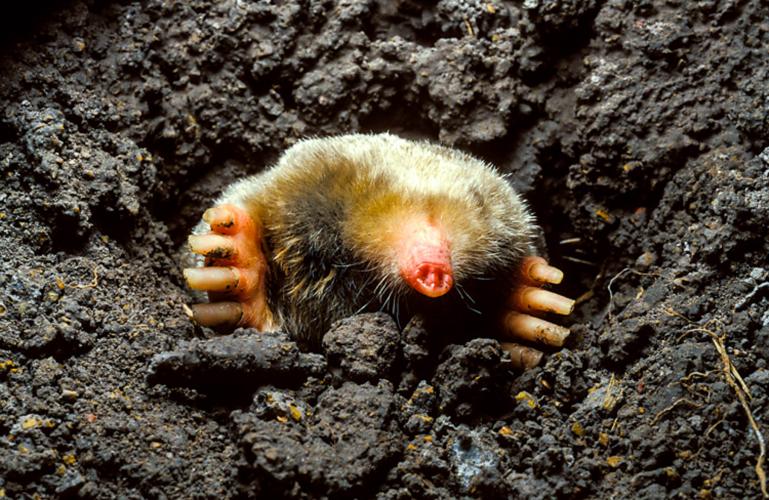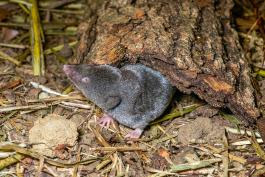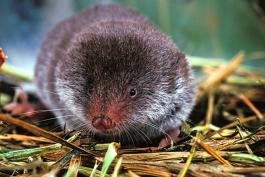
If you’ve ever tried to mow over a molehill, you probably have strong feelings about moles. You may even blame them for chewing up your vegetable garden.
But Missouri’s only mole — the eastern mole — is mainly a meat eater. Yes, it will eat the seeds of oats, wheat, corn, and grass, but it mostly seeks and destroys earthworms, grubs, ants, centipedes, sowbugs, and other invertebrates. If you hate Japanese beetles, you might find a little room in your heart for the eastern mole, which eats their grubs.
The eastern mole’s taste for invertebrates is part of what makes it kin to Missouri’s six kinds of shrews. Moles and shrews may look like rodents, but they’re not. They belong to the order Eulipotyphla (yoo-luh-PAH-tif-luh), which means “truly fat and blind.”
Chunky, Near-Sighted, and Super-Amped
It’s true — moles and shrews are on the chunky side. They need to eat a lot to fuel their super-amped metabolisms, but they’re not blind. They have eyes, but they don’t see well. Instead, moles and shrews rely on their keen senses of hearing, smell, and touch to find prey and mates in their tunnels.
For both moles and shrews, prey is largely insects and other invertebrates. Neither moles nor shrews sleep much. Shrews, in particular, must hunt almost constantly or starve. Some species are even known to take the occasional mouse or gartersnake.
Moles and shrews are also famously stinky. Biologists speculate that their scent glands help them mark territory, communicate with potential mates during breeding season, and ward off would-be predators.
Together, moles and shrews make up the underground branch of nature’s pest-control force.
The Eastern Mole
This chipmunk-sized critter has palmlike front feet that it holds in front of its head, palms facing outward. The mole uses its large front feet to move through the soil in about the same way a person swims underwater. The head looks nearly featureless except for the flexible, piglike snout. Although the mole’s eyes are only good for telling light from dark, its senses of hearing, touch, and smell are acute. The velvety fur is slate gray but often appears silvery or sooty black on juveniles. Its plushlike quality enables the mole to slip easily through the soil, either forward or backward, without getting bits of dirt stuck to the fur. A cinnamon-brown staining on the chin and along the middle of the belly is common on adults. The tail is nearly naked and is highly sensitive to touch.
Habitat and Foods
Moles live in a series of tunnels underground and occur wherever the soil is thick, loose, and cohesive enough to support a tunnel system — and plenty of prey items.
Moles go for grubs and earthworms. They also prey on other soil-dwelling creatures such as beetles, spiders, centipedes, ant pupae, and cutworms. In fact, a mole can gobble up more than 140 grubs and cutworms daily (many of which are destructive to your farm, garden, and landscaping plants). Almost always on the hunt, moles can eat half their body weight a day.
Life Cycle
Each mole has its own system of tunnels and lives a solitary life. Moles are active day and night, resting for about three hours, then becoming active again for around five hours. Moles breed in late winter or spring and have a gestation period of about four to six weeks. Single annual litters of two to five young are born in March, April, or May. Young moles are born naked and helpless, but they grow and develop rapidly. About four weeks after birth, they leave the nest and fend for themselves.
Missouri’s Many Shrews
Shrews are mouselike animals, but they are not mice, and they don’t have the chisel-like front teeth that characterize plant-eating beaver and other rodents. Instead, they have sharp, spiky teeth, which are used for hunting prey. Shrews are more closely related to moles than to any other Missouri mammals. Six species of shrews occur in Missouri, but they share common traits and habits.
Habitat
In general, Missouri shrews run on the ground surface, amid leaf litter, and just under the ground.
Most of our species frequently use runways and tunnels originally built by moles and mice, as well as building their own tunnel systems. Short-tailed shrews may build tunnels extending to nearly 2 feet below the surface, but our other species’ burrows are shallower.
Many shrews live under or deep within decaying logs or stumps, or under rocks. Their nests — where they raise their young, or where they overwinter — are often in chambers of their tunnel systems lined with grass and leaves. The cinereus shrew has specialized chambers for food storage, resting, and raising young.
Shrews are notoriously belligerent to each other. In fact, researchers report that if young shrews follow each other into a trap, one will usually overpower the others and eat them overnight. Therefore, shrews usually live solitarily. However, the least shrew sometimes digs tunnels cooperatively, with more than one individual working on the project. During winter, up to 31 least shrews have been recorded together in one nest, apparently sharing body heat.
Foods
Shrews, like moles, focus on insects and other invertebrates. The short-tailed shrews, being slightly larger, may also eat larger prey, including salamanders, small snakes, birds and their eggs, mice, and other shrews.
Our three species of short-tailed shrews have a powerful venom in their saliva that immobilizes prey and extends the time fresh food is available, so it facilitates food hoarding. Also, it slows the heart and breathing and may break down the muscle tissue of larger victims.
Least shrews typically attack the joints of the jumping legs of crickets and grasshoppers, which helps subdue these insects.
Shrews don’t eat much plant material. Short-tailed shrews, however, are more likely to do so than the other species, especially in winter, when they eat roots, nuts, fruits, berries, and fungi.
Because shrews don’t hibernate, they must continue to eat during the winter. During this time, they seek out dormant insects such as overwintering larvae and pupae in the soil and in rotting logs.
With their high metabolisms and active lives, shrews must eat a tremendous amount of food, relative to their size. The cinereus shrew may eat three times its own body weight every 24 hours. The least shrew can eat 75–100 percent of its own body weight a day, and the short-tailed shrews can eat 50 percent of their weight each day.
Because they feed principally on hard-bodied insects and other small invertebrates, shrews (like bats) have sharp-cusped molar teeth that cut up the hard parts of their prey. The incisors of shrews are modified into grasping pincers that are well suited for holding the hard bodies of the large, struggling insects the tiny shrew feeds upon.
Life Cycle
Most of Missouri’s shrews generally breed from spring through fall, having several litters each year. Short-tailed shrews typically have only one to three litters a year and occasionally breed during winter, too. Shrews usually breed during their first year of life, often by the fall of their first year. Gestation varies by species, but it is generally about 22 days.
Young, about the size of honeybees at birth, develop rapidly and are weaned in about a month. Cinereus shrews are weaned after just 20 days. Least shrews are weaned in three weeks and look fully grown within a month. Southeastern shrews stay in the nest for three to four weeks until fully grown. In most species, the mothers provide all the parental care, but in least shrews, apparently both parents care for the young.
Shrews, especially when young, have a high mortality. They may die of shock, from accidents, and from cold. Short-tailed shrews usually live for only a year or 18 months, with most surviving for no more than one winter, but some may potentially live for three years.
Shrews, like many other mammals, produce odors from glands that signal to others of their species their sex and receptivity for breeding. Their musky odors, rubbed in a tunnel, also signify ownership and help individuals establish their territory.
North American Least Shrew
Cryptotis parva
Sometimes called simply the “least shrew” or the “bee shrew,” this is one of the smallest mammals in Missouri, measuring only about 3 inches from the tip of the nose to the tip of the tail and weighing 1/16 ounce.
The least shrew is generally abundant and probably occurs statewide. Preferred habitats include open grass, brush, and dry, fallow fields, with marshy or timbered areas to a lesser extent.
Three Short-Tailed Shrews
Short-tailed shrews (genus Blarina) have an exceedingly pugnacious and energetic nature. For a long time, they were considered a single, widespread species. Now, four species are recognized, with three occurring in Missouri. Specialists use cranial measurements and DNA sequencing to identify the different species.
Short-tailed shrews occur statewide, but each species’ range is imperfectly known. Their populations can fluctuate wildly from year to year. They live in dark, damp, or wet localities in flooded areas or fields covered with heavy, weedy growth. They occur less often in grassy cover.
Cinereus Shrew
Sorex cinereus
Also known as the masked shrew, the cinereus is distinguished from short-tailed and least shrews by a longer tail, which is more than one-half the length of the head and body, and from the southeastern shrew by a slightly longer tail with an obvious constriction at the base.
In Missouri, it occurs in low, damp areas along streams and in floodplains — although usually not in grasslands — in the northern half of the state.
Southeastern Shrew
Sorex longirostris
Uncommon across Missouri, the southeastern shrew probably occurs in all but the northwest corner of the state. In most of its North American range, it is associated with marshy or swampy areas, or wooded places with dense ground cover. In Missouri, it is known mostly from dry upland sites with some woods.
Mission Critical
Even though they’re subterranean predators, moles and shrews still become prey to hawks, owls, coyotes, weasels, badgers, foxes, cats, dogs, and snakes. Whether predator or prey, moles and shrews play key roles in food webs throughout Missouri. Without them, farmers would have a harder time controlling invertebrate pests, and the populations of top predators would possibly decline.
Moles and shrews, like the proverbial canary in the coalmine, can also indicate local environmental quality. If pesticides kill off their main prey — they will soon disappear, too.
In addition to serving as both predator and prey in local food webs, moles and shrews improve the quality of local soils.
- Hedgehog and Gymnure: Europe, Asia, and Africa
- Solenodon: Cuba and Hispaniola
- Desman: Southwest Russia and Pyrenees
Title
Accommodate or Control?
Because they help keep yard, garden, and farm pests in check, consider tolerating moles and shrews in back lots and borders. Poisoning moles and shrews is not recommended — introducing poison to control one kind of animal inevitably affects the local ecosystem. If they become problems, moles and shrews can sometimes be controlled with traps.
Title
Check Out Missouri’s Online Field Guide
Most of the information for this feature came from Missouri’s online Field Guide, which features more than 1,500 entries with tips on what to look for each season. Head to mdc.mo.gov/field-guide.










Also In This Issue

The culmination of a good nature photo takes patience, research, and getting a little dirty along the way.

Good habitat holds hope for Missouri’s bobwhite hunting tradition
And More...
This Issue's Staff
Stephanie Thurber
EDITOR
Angie Daly Morfeld
ASSOCIATE EDITOR
Larry Archer
PHOTOGRAPHY EDITOR
Cliff White
STAFF WRITERS
Dianne Van Dien
Kristie Hilgedick
Joe Jerek
DESIGNERS
Shawn Carey
Marci Porter
PHOTOGRAPHERS
Noppadol Paothong
David Stonner
CIRCULATION MANAGER
Laura Scheuler






















